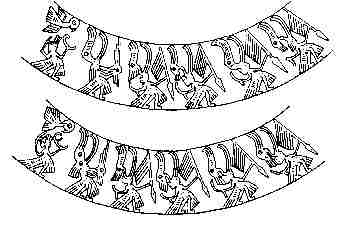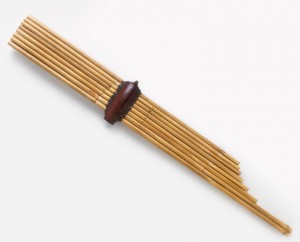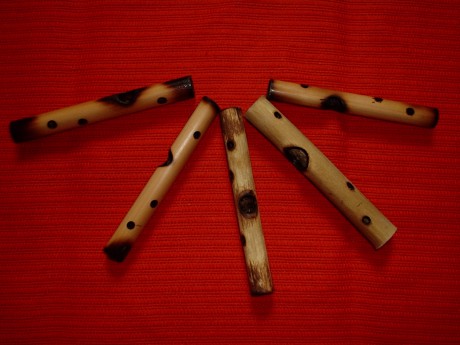Khaen / Kaen / Khene / Ken / Can / Khen
KHAEN (dvojitá řada bambusových píšťal upevněných do zvukové skříně z tvrdého dřeva).
Zábava na Laoském venkově znamená posezení s přáteli a pití Lao Lao (Laoská whisky), vyprávění vtipů, povídání a zpívání. Náboženské slavnosti (kterých mají hodně) jsou příležitostí k shlédnutí tradiční laoské hudby i moderní pop-music. Lidová hudba zvaná Lam je improvizovaný zpěv doprovázený hrou na píšťalu zvanou Khaen. Vypadá trochu jako pannova flétna a hra na ní je poměrně těžká, protože hráč musí udržovat tón při nádechu i výdechu.
Part Three: The Laotian Khaen

| Illustration 16: The Khaen. Photo by Randy Raine-Reusch |
The khaen (also spelled kaen, khene, ken, can and khen) is the Laotian mouth organ; a raft-shaped instrument whose pipes are arranged in two parallel rows. It is the most important instrument of Laos and Northeast Thailand, as it is the most refined in tuning, playing techniques and repertoire. Four sizes are common today: with six, fourteen, sixteen and eighteen pipes. The most common khaen is the sixteen-pipe version, called the khaen paat, which is anywhere from two to three and a half feet in length. The sixteen-pipe khaen plays a two-octave diatonic minor scale; it is tuned in half and whole steps which are similar to Western tuning. The pitch, however, is not standardized and varies considerably between instruments.
The eighteen-pipe version, the khaen gao, that reached six feet and more in length, is rarely seen today. Playing such an instrument was extremely taxing on account of the large amount of wind the players had to provide with their breath. In addition, the instrument was difficult to transport. Prince Henri d'Orleans wrote in 1894, "A man carrying a Laotian organ, which he has difficulty in setting up, follows them [the singers]. The pipes of the organ are so long -- nearly fourteen feet -- that he is finally obliged to cut a hole in the roof, but the damage can be easily repaired." (End note 15) Some khaen measuring three meters long can be seen at the National Museum in Bangkok.
Khaen reeds are made from an alloy of copper and silver and are fitted into the pipe walls inside the hardwood wind chest. The traditional manner of making reeds is to hammer a small coin on a wooden anvil until it is paper thin and cut it to size on a cutting board made from an elephant thighbone. The pipes are sealed into the wind chest with a black substance similar to beeswax called kisoot, a waste-product from the soot insect. Players also pinch off a small piece of kisoot to stop the drone pipes. (End note 16)



